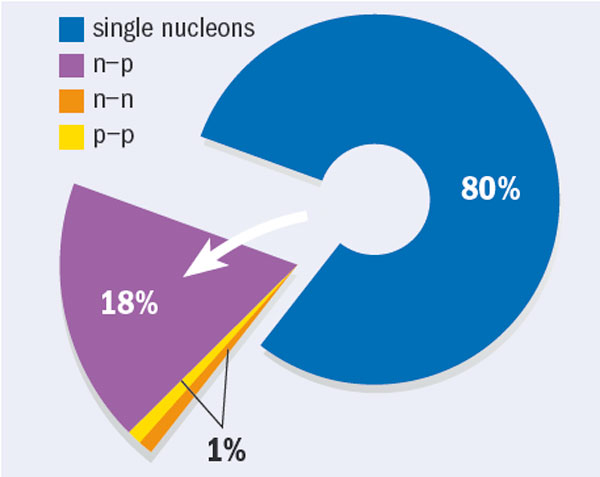Researchers at the Jefferson Lab have found that neutron–proton pairs in the ground state carbon-12 nucleus are far more common than proton–proton pairs and neutron–neutron pairs. As many as 18% of the nucleons are involved in proton–neutron short-range correlations (SRCs), a result that could have implications for neutron stars.
In a typical nucleus, nucleons maintain an average distance of 1.7 fm. However, roughly one-fifth of nucleons are involved in short-range correlations, where two nucleons come to within a femtometre of each other. These pairs can create local densities five times that of average nuclear matter, thus providing a glimpse of dense nuclear matter as found in neutron stars.

Now a team working in Jefferson Lab’s Hall A has made the first simultaneous measurement of SRCs and their constituents. The experiment used an incident electron beam of 4.627 GeV and a carbon-12 target. Proton-knockout events were defined by the two High-Resolution Spectrometers (HRS) in Hall A. The left HRS detected scattered electrons and the right HRS detected knock-out protons. A large acceptance spectrometer (BigBite) and a neutron array detected correlated high-momentum recoiling protons and neutrons, respectively.
The experiment selected (e,e’p) events with high missing momentum, greater than 300 MeV/c, and revealed that the missing momentum was balanced almost entirely by a single recoiling nucleon. This nucleon was initially back to back with the knock-out proton. The team found that 90% of these SRCs involved proton–neutron pairs. The remaining 10% were split between proton–proton and neutron–neutron pairs (Subedi et al. 2008). Calculations of this effect in recent theoretical work indicate that the large prevalence of neutron–proton pairs over proton–proton and neutron–neutron pairs is a result of the nucleon–nucleon tensor force (Sargsian et al. 2005 and Schiavilla et al. 2007).

Together with previous work, including cross-section ratio measurements at Jefferson Lab and proton-knockout experiments at Brookhaven National Laboratory, the new result yields a consistent picture of the short-distance structure of nuclear systems, from light nuclei to neutron stars. Most accepted models of neutron stars assume a make-up of 95% neutrons and 5% protons at the core. The presence of strong short-range, neutron–proton pairing could alter assumptions about the protons’ momenta, thus affecting calculations of the density and/or lifetime of neutron stars.
Further reading
R Subedi et al. 2008 Science 320 1476.
R Schiavilla et al. 2007 Phys. Rev. Lett. 98 132501.
M M Sargsian et al. 2005 Phys. Rev. C 71 044615.







